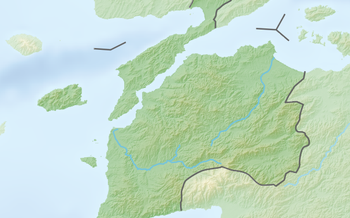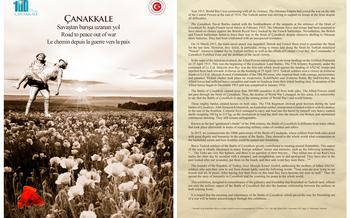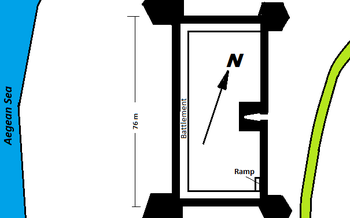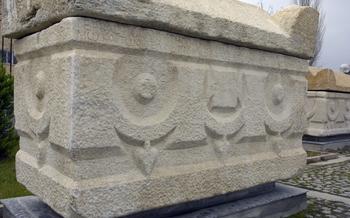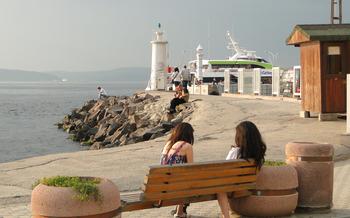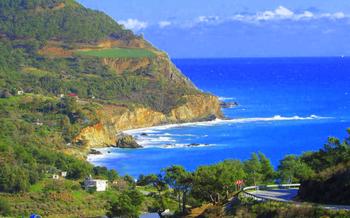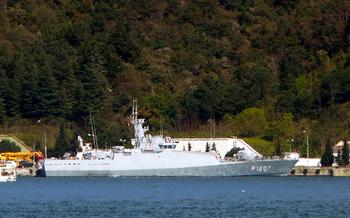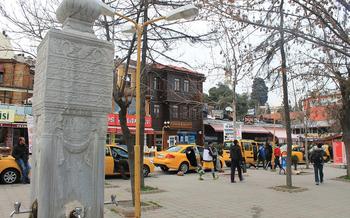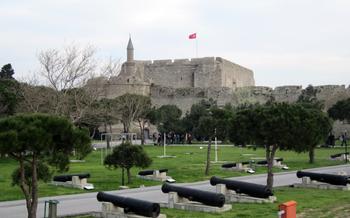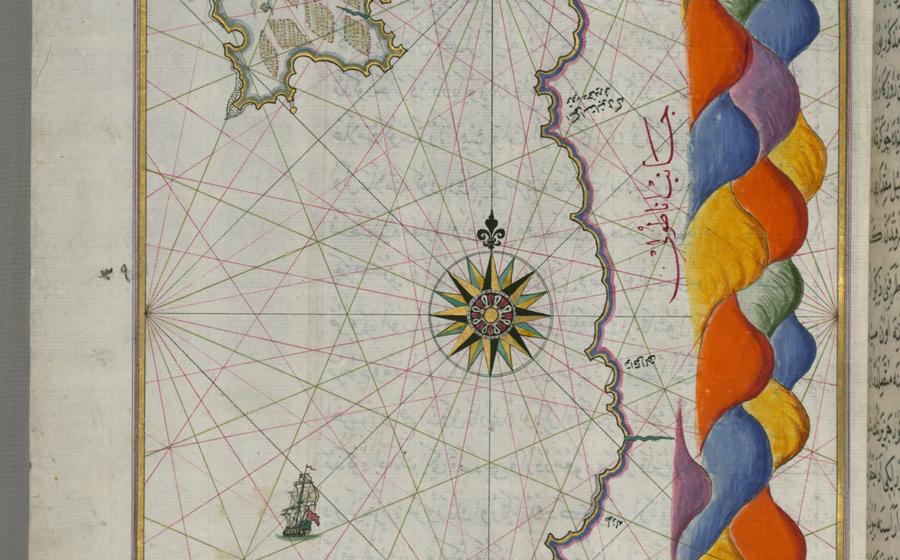
Piri Reis Museum
- Piri Reis Museum: Unveiling the Secrets of Maritime History
- The Man Behind the Maps: Piri Reis
- Exploring the Museum's Treasures
- The Piri Reis Map: A Masterpiece of Cartography
- Maritime Artifacts and Models
- Ottoman Naval History
- Interactive Exhibits and Learning Zones
- Temporary Exhibitions and Events
- Guided Tours and Audio Guides
- Museum Shop and Souvenirs
- Accessibility for Visitors with Disabilities
- Tips for Planning Your Visit
- Photography and Social Media
- Educational Programs for Schools and Groups
- Insider Tip: Hidden Gems of the Museum
Piri Reis Museum: Unveiling the Secrets of Maritime History
The Piri Reis Museum, nestled in the heart of Çanakkale, Turkey, stands as a testament to the rich maritime history of the region. Dedicated to the life and works of the renowned Ottoman admiral and cartographer Piri Reis, the museum invites visitors to embark on a journey through the captivating world of exploration and discovery.
Established in 1957, the Piri Reis Museum has become a significant cultural and historical landmark in Çanakkale. Situated within the walls of the historic Çimenlik Castle, the museum offers a picturesque setting that complements its maritime theme. The castle, once a strategic military stronghold, now houses a treasure trove of artifacts, maps, and exhibits that tell the story of Piri Reis and his contributions to the field of cartography.
The Man Behind the Maps: Piri Reis
Piri Reis was born in Gelibolu, a coastal town in the Ottoman Empire, in 146His father was a renowned Ottoman admiral, and Piri Reis followed in his footsteps, joining the Ottoman navy as a young man. He quickly rose through the ranks, distinguishing himself through his exceptional skills in navigation and cartography.
Piri Reis's contributions to cartography are immense. He compiled and drew several maps, including the famous Piri Reis map of 1513, which depicted the coastlines of the Americas, Europe, and Africa with remarkable accuracy. His maps were based on his own observations, as well as on information gathered from other sailors and explorers.
Piri Reis's work was not limited to cartography. He was also an accomplished admiral and explorer. He led several naval expeditions, exploring the Mediterranean Sea, the Red Sea, and the Indian Ocean. His knowledge of maritime routes and his ability to navigate through treacherous waters made him a valuable asset to the Ottoman Empire.
Piri Reis's legacy extends beyond his maps and explorations. He is regarded as one of the pioneers of modern cartography, and his work laid the foundation for future developments in the field. His contributions to maritime history continue to be studied and admired by scholars and enthusiasts alike.
Exploring the Museum's Treasures
The Piri Reis Museum is a treasure trove of artifacts and exhibits that offer a fascinating glimpse into the world of maritime history and the life of Piri Reis. The museum's collection includes a wide range of exhibits, from ancient navigational instruments to intricate ship models, providing visitors with a comprehensive understanding of the maritime history of the region.
One of the highlights of the museum is the renowned Piri Reis map, a masterpiece of cartography that was created in 15This map is not only a testament to the skill and precision of Piri Reis but also a significant historical document that sheds light on the understanding of the world during that period. Visitors can marvel at the accuracy and detail of the map, which depicts the coastlines of Europe, Africa, and the Americas.
In addition to the Piri Reis map, the museum houses a collection of other valuable artifacts, including navigational instruments such as astrolabes, compasses, and sundials. These instruments played a crucial role in the exploration and navigation of the seas during the Ottoman era and provide insights into the challenges faced by sailors and explorers of the time.
The museum also showcases a series of ship models that illustrate the evolution of naval architecture in the Ottoman Empire. Visitors can see models of various types of ships, from small sailing vessels to large warships, and learn about the construction techniques and design features that were used in shipbuilding during this period.
The Piri Reis Map: A Masterpiece of Cartography
The Piri Reis map, undoubtedly the museum's centerpiece, stands as a testament to the remarkable achievements of Piri Reis. Created in 1513, this map astounds with its accuracy and detail, depicting the coastlines of Europe, Africa, and the Americas with astonishing precision. Its meticulous craftsmanship and incorporation of information from various sources, including Portuguese and Arab maps, showcase Piri Reis's expertise as a cartographer and his commitment to accuracy.
The map has sparked considerable interest and controversy among scholars and historians. Its depiction of Antarctica, centuries before its official discovery, has fueled debates and theories about ancient civilizations and pre-Columbian exploration. While some question its authenticity, the Piri Reis map remains a valuable artifact, providing insights into the maritime knowledge and understanding of the world during the Age of Exploration.
This remarkable map not only showcases Piri Reis's cartographic skills but also highlights the crucial role of Çanakkale in the Ottoman Empire's maritime history. As a strategic naval base, Çanakkale played a pivotal role in the empire's control of the Dardanelles Strait, a vital waterway connecting the Mediterranean and Black Seas.
Exploring the Piri Reis map is a journey through history, revealing the intricate connections between exploration, cartography, and the rise of maritime empires. It invites visitors to ponder the mysteries of the past and marvel at the enduring legacy of Piri Reis, a true pioneer of maritime exploration.
Maritime Artifacts and Models
The Piri Reis Museum boasts a rich collection of maritime artifacts and models, providing visitors with a glimpse into the fascinating world of seafaring and naval history. These exhibits showcase the ingenuity and craftsmanship of Ottoman shipbuilders and navigators.
Among the highlights is a collection of navigational instruments, including compasses, astrolabes, and sextants. These tools were essential for sailors to determine their position and course at sea, demonstrating the advanced level of maritime technology achieved by the Ottomans.
The museum also features a variety of ship models, ranging from small fishing boats to imposing warships. These models illustrate the evolution of naval architecture and the different types of vessels used by the Ottoman navy throughout history. Visitors can admire the intricate details and craftsmanship of these models, which provide a tangible connection to the past.
Furthermore, the museum showcases replicas of Ottoman galleys, the primary warships of the Ottoman navy. These galleys were renowned for their speed and maneuverability, and played a crucial role in the empire's naval victories. Seeing these replicas up close allows visitors to appreciate the size and power of these formidable vessels.
Through these maritime artifacts and models, the Piri Reis Museum offers a captivating journey into the world of Ottoman naval history, highlighting the empire's contributions to seafaring and exploration.
Ottoman Naval History
The Piri Reis Museum also sheds light on the rich naval history of the Ottoman Empire. The Ottoman navy, once a formidable force in the Mediterranean and beyond, played a crucial role in shaping the course of history. Visitors can delve into the fascinating story of the Ottoman navy's rise and fall through captivating exhibits and displays.
The museum showcases key naval battles that shaped the empire's destiny, such as the Battle of Lepanto in 1571, which marked a turning point in Ottoman naval dominance. Explore the strategies employed by Ottoman admirals, the technological advancements that propelled their fleet, and the impact of their victories and defeats on the geopolitical landscape of the time.
Çanakkale, the city where the museum resides, holds a special significance in Ottoman naval history. As the gateway to the Dardanelles Strait, a strategic waterway connecting the Aegean and Black Seas, Çanakkale served as a vital naval base for the Ottomans. Discover how the city's strategic location influenced the empire's maritime power and explore the fortifications and shipyards that once guarded this critical passage.
Through interactive displays, visitors can gain insights into the shipbuilding techniques and naval architecture of the Ottoman Empire. Learn about the construction of galleys, frigates, and other vessels that formed the backbone of the Ottoman fleet. Understand how these ships were designed to maneuver through diverse sea conditions and withstand the rigors of battle.
The Piri Reis Museum offers a comprehensive exploration of Ottoman naval history, providing visitors with a deeper understanding of the empire's maritime prowess and its lasting impact on the Mediterranean region and beyond.
Interactive Exhibits and Learning Zones
The Piri Reis Museum offers a range of interactive exhibits and learning zones designed to engage visitors of all ages. These interactive displays make learning about maritime history fun and accessible, providing hands-on experiences and educational resources that complement the museum's exhibits.
For children, there is a dedicated play area where they can explore the world of navigation and exploration through interactive games and activities. They can build their own ships, solve maritime puzzles, and learn about different sea creatures.
Adults can also enjoy interactive exhibits that allow them to delve deeper into the history of cartography and naval warfare. They can try their hand at using traditional navigational instruments, simulate sailing routes on a virtual map, and learn about the challenges faced by early explorers.
The museum also features educational zones that focus on specific aspects of maritime history, such as navigation, geography, and exploration. These zones provide detailed information, multimedia presentations, and interactive maps that help visitors understand the complexities of seafaring and its impact on world history.
Temporary Exhibitions and Events
The Piri Reis Museum is not just a static display of artifacts; it also hosts a variety of temporary exhibitions and events throughout the year. These exhibitions often focus on specific aspects of maritime history, exploration, or cartography, offering visitors a chance to delve deeper into these fascinating subjects.
Special events, such as workshops, seminars, and lectures, are also organized regularly. These events provide opportunities for visitors to learn from experts in the field, engage in discussions, and gain new perspectives on maritime history.
To stay updated on upcoming programs and events, be sure to check the museum's website or social media pages. The museum also offers a newsletter service that allows visitors to receive regular updates on upcoming exhibitions and events.
By participating in these temporary exhibitions and events, visitors can gain a deeper understanding of maritime history and the legacy of Piri Reis, while also enjoying a more interactive and engaging museum experience.
Guided Tours and Audio Guides
Enhancing the museum experience, guided tours are available in multiple languages, providing visitors with a deeper understanding of the exhibits. Led by knowledgeable guides, these tours offer insights into the life and work of Piri Reis, the significance of his maps, and the broader context of Ottoman maritime history. The guides are passionate about sharing their expertise, ensuring that visitors leave with a rich appreciation for the museum's treasures.
For those who prefer a self-paced exploration, audio guides are available in several languages. These audio guides offer a comprehensive commentary on the exhibits, allowing visitors to delve into the details at their own pace. The audio guides are particularly beneficial for those interested in learning more about specific aspects of the museum's collection or for those who want to revisit certain exhibits.
Museum Shop and Souvenirs
The Piri Reis Museum offers a delightful array of souvenirs and gifts that cater to the interests of history buffs, maritime enthusiasts, and travelers alike. Step into the museum shop and discover a treasure trove of nautical-themed mementos that will serve as lasting reminders of your visit to Çanakkale.
One of the highlights of the museum shop is the collection of Piri Reis map replicas. These meticulously crafted reproductions capture the essence of the renowned cartographer's groundbreaking work and make for exceptional souvenirs. Choose from various sizes and formats to find the perfect replica to adorn your home or office.
In addition to the Piri Reis maps, the museum shop offers a diverse selection of nautical-themed gifts. Browse through an assortment of model ships, ranging from intricate replicas of Ottoman galleys to modern warships. These models provide a glimpse into the evolution of naval architecture and make for captivating display pieces.
For those seeking educational souvenirs, the museum shop stocks a range of books on maritime history, navigation, and exploration. These publications delve into the fascinating world of seafaring and offer insights into the remarkable achievements of Piri Reis and other renowned explorers.
By purchasing souvenirs from the Piri Reis Museum, you not only take home a piece of history but also support the museum's ongoing efforts to preserve and promote maritime heritage. Every purchase contributes to the museum's mission of educating and inspiring future generations of explorers and history enthusiasts.
Accessibility for Visitors with Disabilities
The Piri Reis Museum is committed to ensuring an inclusive and enjoyable experience for all visitors, including those with disabilities. To this end, the museum has implemented several accessibility features:
-
Wheelchair accessibility: The museum is wheelchair accessible, with ramps and elevators providing easy access to all floors.
-
Accessible restrooms: There are accessible restrooms located throughout the museum, equipped with grab bars and wide doorways.
-
Audio guides: Audio guides are available for rent, providing detailed descriptions of the exhibits. These guides can be used with personal headphones or the museum's assistive listening devices.
-
Trained staff: The museum staff is trained to assist visitors with disabilities, providing guidance and assistance as needed.
-
Visitor assistance: Visitors with disabilities who require additional assistance can contact the museum's visitor services department in advance to arrange for specific accommodations.
With these accessibility features in place, the Piri Reis Museum welcomes visitors of all abilities to explore the fascinating world of maritime history and cartography.
Tips for Planning Your Visit
To make the most of your visit to the Piri Reis Museum, plan to spend at least two hours exploring the exhibits and learning about the fascinating world of maritime history. Combine your museum visit with other attractions in Çanakkale, such as the Çanakkale Martyrs' Memorial or the Çanakkale Naval Museum, for a comprehensive understanding of the region's rich naval heritage.
To avoid crowds and ensure a more personalized experience, plan your visit during the shoulder seasons (April-May and September-October) or on weekdays. The museum is closed on Mondays, so plan accordingly. Remember to bring comfortable shoes as you'll be doing a lot of walking and standing while exploring the exhibits.
Photography and Social Media
Capturing Memories: The Piri Reis Museum encourages visitors to capture their experiences through photography and videos. With the vibrant exhibits and stunning displays, there are plenty of opportunities to take memorable shots. However, it is important to be mindful of the museum's guidelines to ensure that everyone has a pleasant visit. Flash photography is not permitted as it can damage the delicate artifacts. Visitors are also requested to be respectful of other visitors and avoid blocking their views or disturbing their exploration.
Share Your Discoveries: Once you have captured your memories, the Piri Reis Museum encourages you to share them with the world. Social media platforms provide an excellent opportunity to connect with fellow travelers, share your insights, and inspire others to visit this incredible museum. Use relevant hashtags, such as #PiriReisMuseum, #Canakkale, and #MaritimeHistory, to reach a wider audience. Your posts can help raise awareness about this hidden gem and encourage others to embark on their own journey of discovery.
Creating a Community: The Piri Reis Museum community on social media is a vibrant and passionate group of enthusiasts who share their love for maritime history, cartography, and exploration. By sharing your experiences and tagging the museum, you can become a part of this community and connect with like-minded individuals. Engage in discussions, share your favorite exhibits, and ask questions to deepen your understanding of the fascinating world of Piri Reis and his contributions.
Educational Programs for Schools and Groups
The Piri Reis Museum offers a range of educational programs tailored to students of all ages, from primary to high school. These programs aim to engage students with the museum's exhibits and teach them about the history of cartography, navigation, and maritime exploration.
School groups can book guided tours that focus on specific topics or themes, such as the life of Piri Reis, the significance of his maps, or the history of the Ottoman navy. Tours can be customized to align with school curricula and learning objectives.
The museum also offers group discounts and special arrangements for schools. Teachers can contact the museum's education department to discuss their requirements and make reservations.
In addition to guided tours, the museum has dedicated educational zones and interactive exhibits that cater to younger visitors. These zones feature hands-on activities, multimedia presentations, and games that help students learn about navigation, geography, and exploration in a fun and engaging way.
By visiting the Piri Reis Museum, students can gain valuable insights into the history of cartography, maritime exploration, and the Ottoman Empire. The museum's educational programs provide an excellent opportunity for students to learn about these topics in a hands-on and interactive environment.
Insider Tip: Hidden Gems of the Museum
Beyond the main exhibits, the Piri Reis Museum holds several hidden gems that offer unique insights into maritime history. One such gem is the collection of ancient navigational charts, which provide a glimpse into the methods used by early seafarers. Another hidden treasure is the replica of the Ottoman galleon, which allows visitors to experience the grandeur of these majestic ships. For those interested in the technical aspects of shipbuilding, the museum's model workshop offers a fascinating look into the intricate process of constructing wooden sailing vessels.
To discover these hidden gems, take the time to explore the museum's nooks and crannies. Engage with the friendly and knowledgeable staff, who are always willing to share their insights and point you towards lesser-known exhibits. By delving deeper into the museum's treasures, you'll gain a richer understanding of maritime history and the legacy of Piri Reis.
